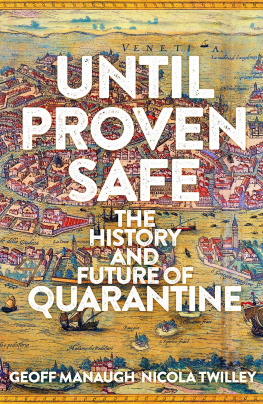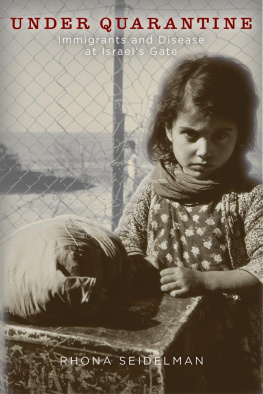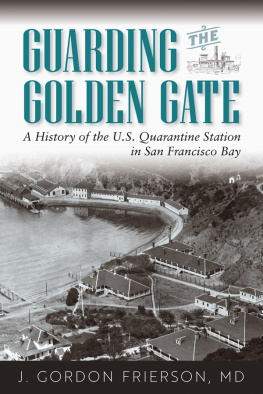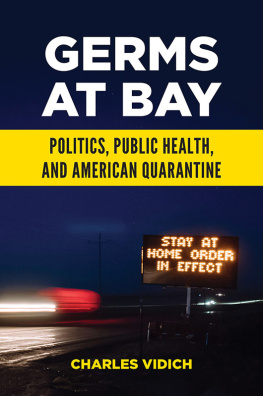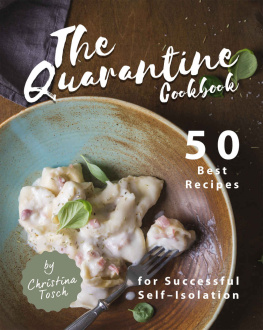Authors Note
To avoid confusion, we use we or us throughout the book, even for a few interviews and events where only one of us was present.
UNTIL
PROVEN
SAFE
GEOFF MANAUGH is the author of the New York Times-bestselling book A Burglars Guide to the City, as well as the architecture and technology website BLDGBLOG. He regularly writes for the New York Times Magazine, Atlantic, the New Yorker, Wired, and many other publications.
NICOLA TWILLEY is co-host of the awardwinning podcast Gastropod, which looks at food through the lens of history and science, and a frequent contributor to the New Yorker.
Geoff Manaugh and Nicola Twilley live in Los Angeles.
Acknowledgments
Our journey through quarantine began in the autumn of 2009, long before the specific idea for Until Proven Safe took shape. For four months in New York City that autumn, we hosted weekly conversations with a small group of architects, artists, designers, and writers to explore what the concept of quarantineisolation and risk, exposure and uncertaintymight mean in their respective fields. The results of that research, from short fiction to theatrical set designs, were then displayed at Storefront for Art and Architecture in spring 2010 under the title Landscapes of Quarantine. We thank Joe Alterio, Front Studio (Yen Ha and Michi Yanagishita), Scott Geiger, Katie Holten, Jeffrey Inaba, Ed Keller, Mimi Lien, Richard Mosse, Daniel Perlin, Thomas Pollman, Kevin Slavin, Brian Slocum, Smudge Studio (Elizabeth Ellsworth and Jamie Kruse), and Amanda and Jordan Spielman for participating in those early, formative conversations. We also thank Glen Cummings for his superb exhibition design and Joseph Grima, the then director of Storefront, for allowing us to curate that exhibition in the first place.
Throughout years of travel, beginning in 2016, we benefited at every turnat every port, harbor, and libraryfrom the intellectual camaraderie and personal generosity of dozens. We owe thanks to the following people, in particular: Judith Allton, Joanne Andreadis, David Barnes, Dr. Mark Barnes, Alison Bashford, Dr. Georges Benjamin, James Benardini, Dr. Luigi Bertinato, Penelope Boston, Dr. Sylvie Briand, Dirk Brockmann, Dr. Clive Brown, Birsen Bulmu, Dr. John Cachia, Dr. Martin Cetron, Guillaume Chabot-Couture, Dr. Ted Cieslak, Eugene Cole, James Colgrove, Cris Collinsworth, Catherine Conley, Stephanie Dahl, Ugo Del Corso, Richard DeLighter, Tatyana Eatwell, Jennifer Elsea, Mike Famulare, Nicolina Farrugia, Gerolamo Fazzini, Debbie Felton, Matthew Fulks, Dr. Julie L. Gerberding, Wayt Gibbs, Lawrence Gostin, Owen Guo, Paul Hadley, Dr. Margaret Hamburg, John Henneman, Col. Dr. Matthew Hepburn, Kaci Hickox, Stephen Higgs, Nancy Hollander, Dr. Tom Inglesby, Dr. Sir Mike Jacobs, Michele Jacobsen, Yue Jin, Dr. Papy Katabuka, Shahryar Kianian, Allison Klajbor, Gerhard Kminek, James Kolmer, Dr. Phyllis Kozarsky, Adam Kucharski, Heather Lake, Elizabeth Landau, Dr. Patrick LaRochelle, Dr. Herbert Lenicker, Rachel Lookadoo, Krista Maglen, Simon McKirdy, Jill Morgan, Angela Munari, (Ret.) General Richard Myers, Nathan Myhrvold, Roger Nelson, Paolo Nespoli, Snjeana Perojevi, Noa Pinter-Wollman, Lisa Pratt, Fausto Pugnaloni, Sara Redstone, Jonathan Y. Richmond, Matthew Rouse, Edward Said, Bobby St. John, (Ret.) Chief Engineer Todd T. Semonite, James Stack, Jay Stanley, Jill Stelfox, Les Szabo, Ron Trewyn, Bahar Tuncgenc, Dr. Patrick Ucama, Abraham Van Luik, Denis Vandervelde, Marty Vanier, Dr. Anthony Vassallo, Mitch Vega, Kasthuri Venkateswaran, Erin Westgate, and Paige Williams.
While conducting much of the research and reading for this book, we relied on the resources of the Wellcome Library in London, the Querini Stampalia Library in Venice, and Sci-Hub online.
We owe a huge thanks to our editors. In the United States, Sean McDonald displayed both patience and prescience in sending us off to research six hundred years of quarantine. Our entire team at MCD / Farrar, Straus and Giroux worked tirelessly to see this book through to publication. In the U.K., Georgina Morley offered us an early expression of interest and encouragement that helped the books initial form take shape. Our agent, Nathaniel Jacks, was a source of support throughout. Those elements previously published by The New Yorker and The New York Times benefited immensely from the editorial attention of Anthony Lydgate and Alan Burdick, respectively. Wayne Chambliss offered ongoing intellectual support and an extremely helpful close read.
Any remaining errors in the text, of course, are our own.
Geoff Manaugh would also like to thank Mnica Belevan for inviting him to join the COVID-19 prepper list described in chapter 1; Benjamin Bratton, Nicolay Boyadjiev, and Olga Tenisheva at the Strelka Institute for multiple invitations to lecture on quarantine for their students in Moscow, Russia; the Canadian Centre for Architecture for an invitation to deliver a talk called Cities of the CDC, on architecture, medical infrastructure, and the future of quarantine, back in 2009; and, of course, Nicola Twilley for everything so far and many more decades together to come.
Nicola Twilley would also like to thank her Gastropod cohost Cynthia Graber for her endless patience; Victoria Wade for her commitment to worrying about deadlines; Ellie Robins and Lizzie Prestel for the accountability; Siri Carpenter and Christie Aschwanden for their advice and encouragement; Anne Roughley for a delightful picnic at Q Station; and, of course, Geoff Manaugh for all the good ideas, from getting married to writing this book together.
The Coming Quarantine
On March 6, 2020, a King County, Washington, health department van pulled up in front of an Econo Lodge motel outside Seattle. An employee clad in white coveralls hopped out, grabbed tools from the back of his van, and proceeded to paint the motels still-glowing sign pitch-black. The red and yellow colors of the chains familiar logo quickly disappeared, replaced by a matte-black rectangle that loomed over the street like a pirate flag. Ominous, deathly, its former welcoming light now extinguished, the motel had become a quarantine facility.
The lo-fi nature of the motels transformation was an unsettling indicator of just how improvised and ad hoc quarantine preparations seemed to be when a new infectious diseaseknown as COVID-19first arrived in the United States. As this novel coronavirus spread exponentially and hospital beds filled up, public health officials realized that they had nowhere to put people who could not quarantine at home.
Instead, buildings such as this roadside motelpurchased by Washington State health officials for $4 millionwere hastily retrofitted, becoming part of the nations emergency medical infrastructure overnight. In this case, the motels rooms were already equipped with independent HVAC units, doors that opened to the outside, and seamless, easy-clean floors. All it took to complete the transformation was a coat of black paint.

That same week, a friend of ours invited us to join an international preppers list hosted on the encrypted communication app Telegram. The purpose of the list was allegedly to help its members prepare themselves and their families for what appeared to be an imminent national lockdown; there were tips for securing enough toilet paper, advice on baking bread, and tales of making a first-time handgun purchase.
In the many thousands of messages hosted by the group, posted by often-anonymous users from around the world, we saw a sign of things to come in terms of public perception of the coronavirus pandemic. Some members wondered aloud about imaginary connections between COVID-19 and 5G wireless technology; others began formulating a muddled conspiracy theory in which the billionaire Bill Gates planned to use a future vaccine to inject electronic nanoparticles into human subjects against their will. If there was any doubt that global health authorities had lost control of the information war before the pandemic had even really started, this Telegram group quickly dispelled it.

